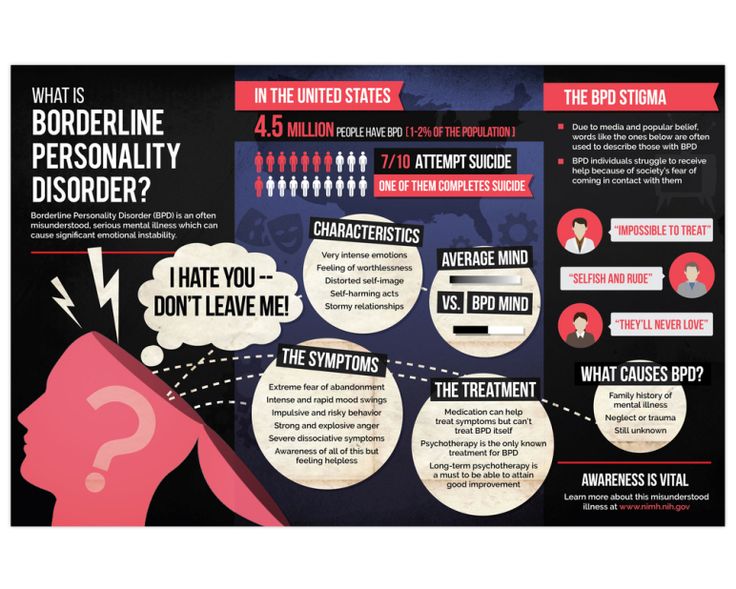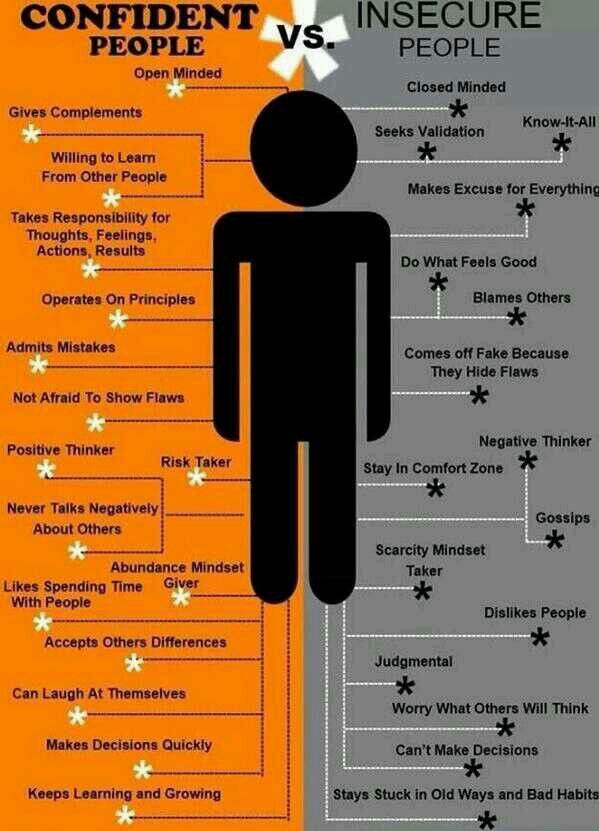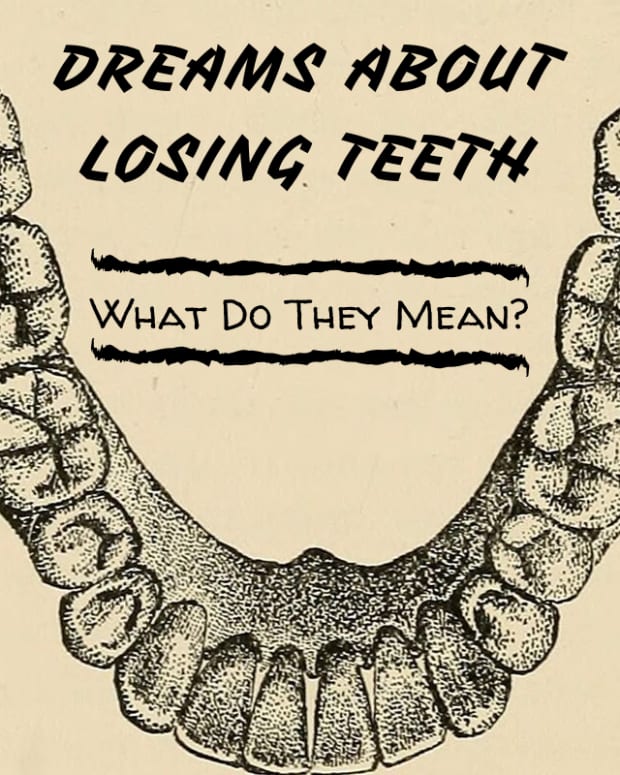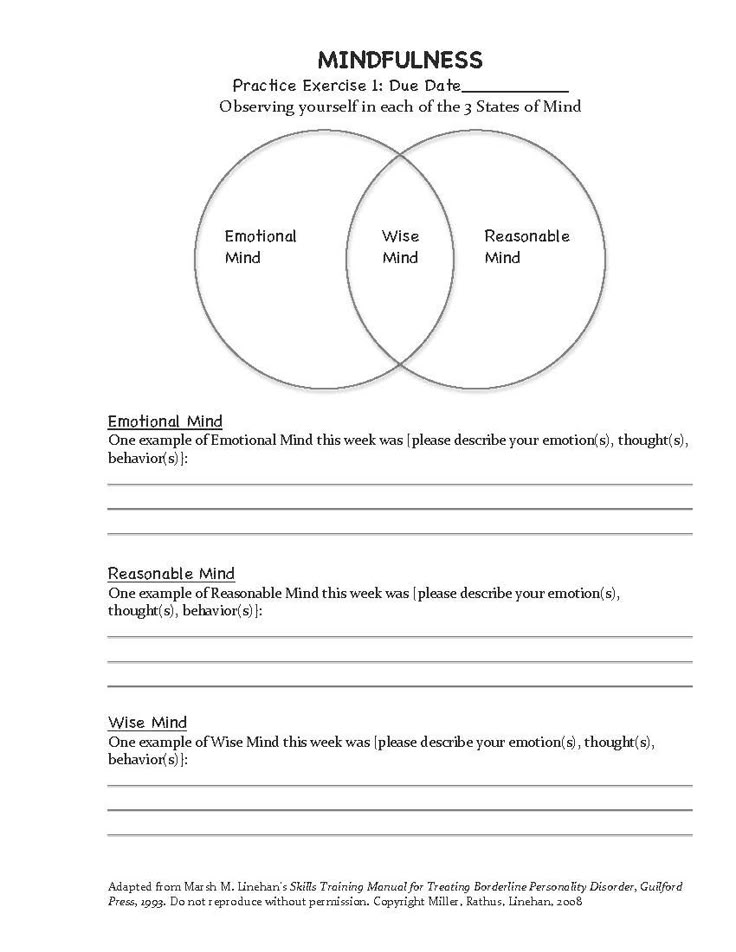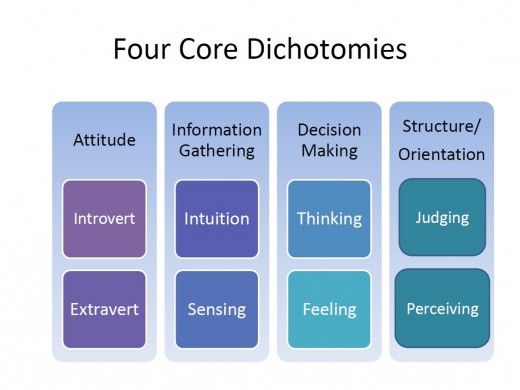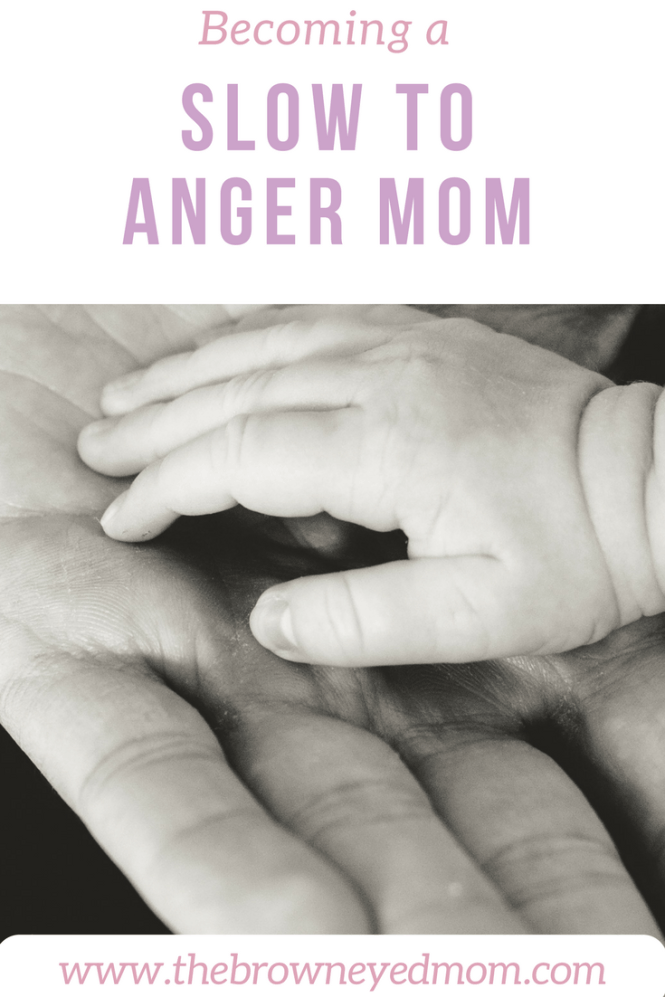Borderline personality in men
Borderline Personality Disorder in Men
Borderline Personality Disorder (BPD) is a condition that affects suffers’ ability to control their emotions, maintain relationships, and engage in impulsive and self-harming behaviors. In the past, BPD was more frequently diagnosed in women than in men.
There are a couple reasons that may have influenced BPD diagnoses: first, pre-established societal biases, which commonly refer to women as being more “emotional” compared to men; and second, women are more likely to seek out mental health treatment while men are more likely to end up in trouble with the authorities for being aggressive and/or violent.
Additionally, men who displayed intense emotions were often misdiagnosed with other disorders instead, such as conduct disorder, attention deficit disorder, oppositional defiant disorder, bipolar disorder, or psychosis. BPD can be challenging to diagnose in women and even more so in men.
For More Information About Our Treatment Programs in Los Angeles
Call Us At: (866) 339-3544
Symptoms of Borderline Personality Disorder
BPD can manifest itself differently in men than in women. Men with BPD may exhibit paranoid, narcissistic, and antisocial behaviors. BPD in Men may also be expressed through substance abuse or addiction to sex, shopping, or gambling.
Other Signs of BPD in Men
Inability to Commit: While both men and women with BPD experience relationship struggles, some males with BPD may date many women at the same time while refusing to commit to any of their partners out of fear of abandonment. Others may scare their lovers away with aggressive behaviors, extreme jealousy, and quick tempers. Some men may begin to reject all relationships, including friendships.
Blame Shifting: Blame shifting can happen when a man with BPD attributes feelings of failure, disapproval, guilt, and deficiency to other people they hold responsible, often toward those they love. In many cases, the person receiving the blame is either not at fault or contributed to the struggle unknowingly. Men with BPD may struggle to accept responsibility if they are at fault, not knowing how to cope with their overwhelming feelings of guilt and despair.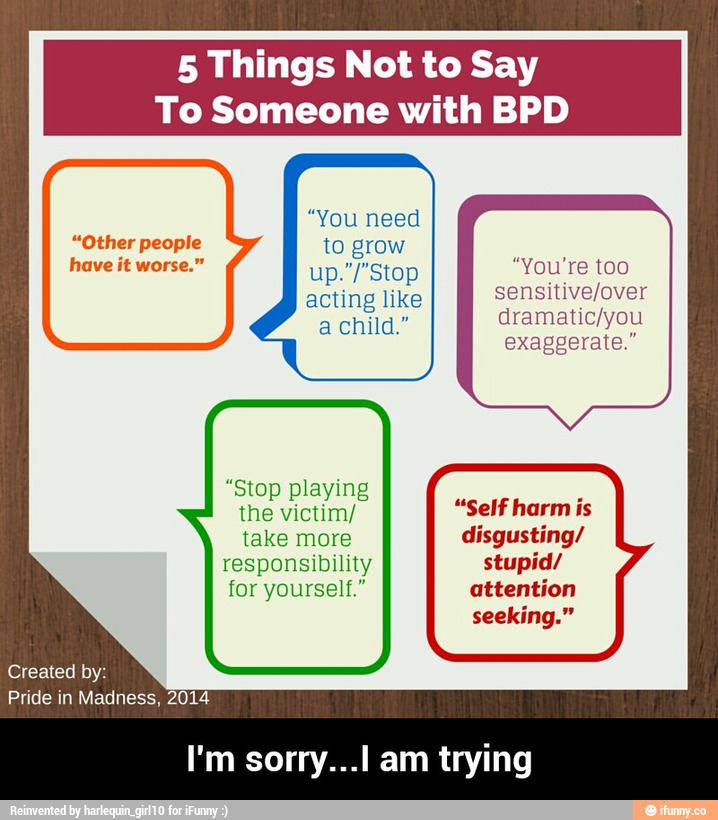
Being Emotionally Sensitive: Men with BPD may be emotionally sensitive, perceiving most everything as personal attacks, and feeling criticized by any remarks made about them. I wouldn’t use that word here. It sounds pretty judgmental.
Narcissistic and Controlling Behaviors: Many men with BPD are subconsciously inclined to compensate for the lack of control they feel, or that they experienced as children, by attempting to control all of their adult relationships. They may make extreme threats to demonstrate their feelings, such as threatening a partner with an affair or actually acting out sexually with others to gain attention.
Boundary Issues: Some men with BPD may struggle to accept boundaries placed on them, sometimes acting forcefully but unwilling to self-regulate.
Treatment for Men with BPD
Men struggling with BPD can find help through proper treatment. Dialectical behavior therapy (DBT) is the most common treatment of borderline personality disorder. It is based on cognitive principles that aim to teach BPD patients how to control the emotions that cause problems in their lives and relationships. DBT consists of both individual sessions and group skills training. Many therapists make themselves available when not in session in the event of any crises and can often be reached by telephone. Treatment may improve your feelings about yourself along with your ability to function.
It is based on cognitive principles that aim to teach BPD patients how to control the emotions that cause problems in their lives and relationships. DBT consists of both individual sessions and group skills training. Many therapists make themselves available when not in session in the event of any crises and can often be reached by telephone. Treatment may improve your feelings about yourself along with your ability to function.
If you or a loved one exhibits any symptoms of borderline personality disorder, professional treatment can help. If you have a co-occurring problem with drug or alcohol addiction, a residential treatment center could be the best place to begin your recovery. Or, you may need assistance through outpatient treatment programs that teach you how to manage your emotions, behaviors, and thoughts. Please call us at (866) 339-3544 or submit the form below to learn more about our treatment programs in Los Angeles.
Guide to Borderline Personality Disorder (BPD) in Men
Skip to contentPublished: July 26, 2022 Updated: November 24, 2022
Published: 07/26/2022 Updated: 11/24/2022
Borderline Personality Disorder(BPD) is a mental disorder characterized by an instability in mood, behavior, self-image, relationships, and impulse control. Men with BPD tend to experience drastic shifts in mood and feel their emotions with great intensity. While a lifelong diagnosis, with an effective treatment plan in place, those suffering from BPD can learn healthy coping mechanisms and symptom management techniques.
Men with BPD tend to experience drastic shifts in mood and feel their emotions with great intensity. While a lifelong diagnosis, with an effective treatment plan in place, those suffering from BPD can learn healthy coping mechanisms and symptom management techniques.
Find a supportive therapist that has expertise in how BPD affects men. BetterHelp has over 20,000 licensed therapists who provide convenient and affordable online therapy. BetterHelp starts at $60 per week. Complete a brief questionnaire and get matched with the right therapist for you.
Choosing Therapy partners with leading mental health companies and is compensated for marketing by BetterHelp
Visit BetterHelp
What Is Borderline Personality Disorder?BPD often presents as displays of intense anger, antisocial behavior, substance use, suicidal ideation or attempts, and novelty seeking. Despite typically exhibiting more aggressive behaviors than women with BPD, men suffering from the condition often go either misdiagnosed or undiagnosed altogether.
A variety and combination of symptoms may suggest that a man is experiencing BPD, including interpersonal difficulty, seeking new experiences with intense emotional sensations, quick shifts in mood (“acting hot and cold”), feelings of emptiness, and uncertainty about one’s identity. Men may be extremely sensitive and easy to anger.
Symptoms of borderline personality disorder in men may include:2
- Difficulty in relationships
- Displays of intense anger
- Aggression
- Impulsive behaviors
- Uncertainty and difficulty with sense of self
- Novelty seeking,(i.e. substance use and other risky behaviors)
- Self-harm behavior
- Suicidal ideation
- Extreme sadness
- Quick shifts in mood
Although a person of any gender may experience the same symptoms, there are signs of BPD more often found in men, including intense displays of anger,antisocial behavior, and substance use, among others. This is possibly due to a man’s propensity to engage in externalizing behaviors, compared to a woman’s tendency to internalize symptoms.2
This is possibly due to a man’s propensity to engage in externalizing behaviors, compared to a woman’s tendency to internalize symptoms.2
Here are eight potential signs of BPD in men:
1. Displays of Intense AngerMore so than their female counterparts, men with BPD struggle with extreme anger, explosive episodes, aggression, and violence. Research suggests this may be due to deficiencies in an area of the brain known as the lateral prefrontal cortex, which is responsible for sending signals that calm the parts of the brain that respond quickly to perceived threats.3
2. Antisocial BehaviorOne study found that antisocial personality traits–such as lying, lacking empathy, and disregarding right and wrong– occurred in 57% of men versus 26% of women.1,4 Antisocial behaviors may be signs of BPD when they are done in an effort to avoid abandonment (e.g., conning someone to get them to stay in a relationship with them) or as a means of demonstrating intense anger towards someone else (e.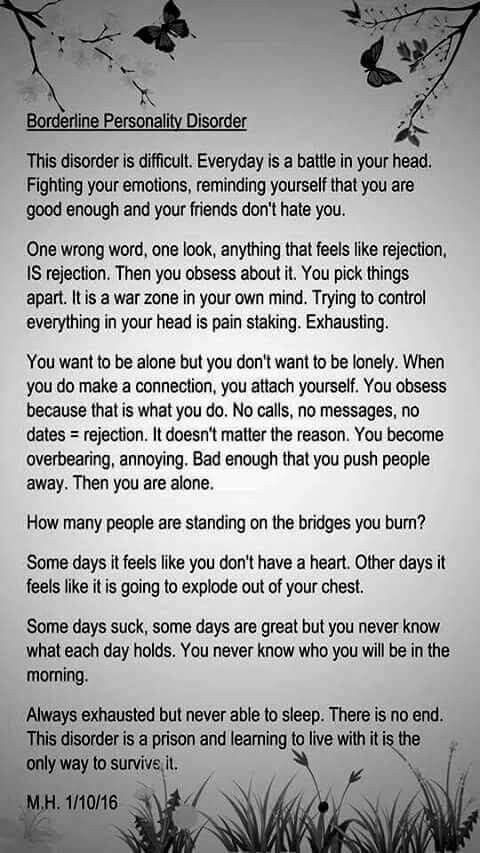 g., bullying or engaging in physical altercations).
g., bullying or engaging in physical altercations).
Men with BPD are significantly more likely to abuse substances than women.1,5 Those who engage in such behaviors tend to experience negative affect, alexithymia, and dissociation.2 They may use substances as a way of coping with these and other symptoms, as an impulsive behavior, or as a means of self-harm, all of which are common in those with BPD.
4. ImpulsivityImpulsivity is a core symptom of BPD and involves engaging in risky or careless behaviors without consideration of long-term consequences. Whereas women with BPD may engage in impulsivity through eating or dieting habits, men with BPD are more likely to act out against others or use substances.5,6 Additionally, while these behaviors are common for BPD patients, some experts believe that impulsive BPD is its own subtype
5. Self-Harm BehaviorSelf-harm is a common symptom of BPD, affecting 65-80% of people with a diagnosis.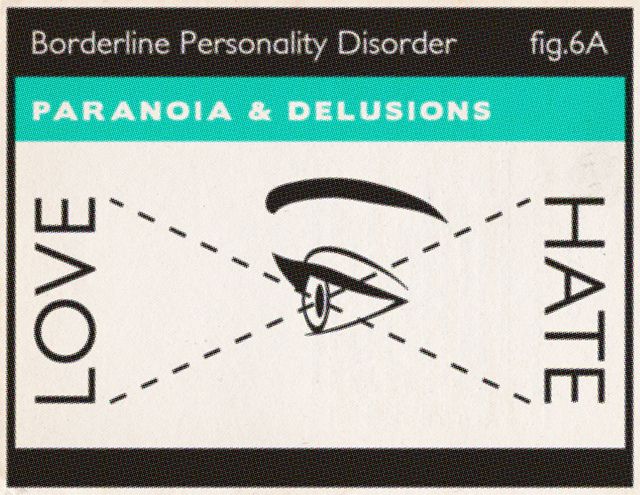 7 In men, self-harm can take many forms, including cutting, burning, punching (oneself or objects), and head-banging. These actions may serve a variety of functions including garnering a sense of agency or distracting from emotional pain. They could also be due to one believing they are deserving of punishment.
7 In men, self-harm can take many forms, including cutting, burning, punching (oneself or objects), and head-banging. These actions may serve a variety of functions including garnering a sense of agency or distracting from emotional pain. They could also be due to one believing they are deserving of punishment.
Like self-harm, suicidality (both thinking about and acting on the desire to complete suicide) is characteristic of BPD and may serve a variety of functions (e.g., escape from reality, chronic emptiness, hopelessness, and feelings of worthlessness). Men with comorbid unipolar depression or bipolar disorder are twice as likely to commit suicide compared to women with BPD.2
7. Unstable RelationshipsMen with BPD will often form insecure attachments and make their dependency, insecurity, and fear of abandonment known to loved ones. This may manifest as revenge-seeking behaviors or aggression toward friends when feeling left out. Men with BPD may also engage in splitting, which involves viewing others as all “good” or all “bad.” Additionally, men may have an unstable relationship with themselves, sometimes resulting in frequent career changes and/or rapidly changing interests
Men with BPD may also engage in splitting, which involves viewing others as all “good” or all “bad.” Additionally, men may have an unstable relationship with themselves, sometimes resulting in frequent career changes and/or rapidly changing interests
Men with BPD are more likely to experience symptoms of vulnerable and grandiose narcissism.8 While these symptoms may be indicative of a comorbid narcissistic personality disorder (NPD) diagnosis, they may also be an attempt to cope with an unstable sense of self or sensitivity to others’ criticism or rejection.
Help For BPD
Talk Therapy – Get help living with Borderline Personality Disorder from a licensed therapist. Betterhelp offers online therapy starting at $60 per week. Get matched With A Therapist
DBT Skills Group For DBT – Dialectical Behavioral Therapy (DBT) is one of the most popular treatments for BPD. Learn DBT skills in this 12-week online group class. Learn More
Learn More
Books On BPD – Read our handpicked Best Books on BPD.
Choosing Therapy partners with leading mental health companies and is compensated for marketing by BetterHelp and Grouport.
Why BPD in Men Often Goes UndetectedOftentimes, BPD goes underdiagnosed or undetected in men for a number of reasons. Research shows that women with BPD are three times more likely to receive an accurate diagnosis than men.9
This may be due to a number of factors including gender differences in clinical presentation, clinician bias, and differences in the treatment settings.
A BPD diagnosis may be overlooked in men because of:
- Clinical Presentation: Gender differences in presentation of symptoms may lead to men’s symptoms being disregarded or attributed to an entirely different issue (i.e., substance use disorder).
- Clinician Bias: While findings on clinician bias are mixed, one possible explanation for men’s underdiagnosis of BPD is that clinicians perceive intense anger in women as diagnostic, whereas for men they view it as characteristic of masculinity.
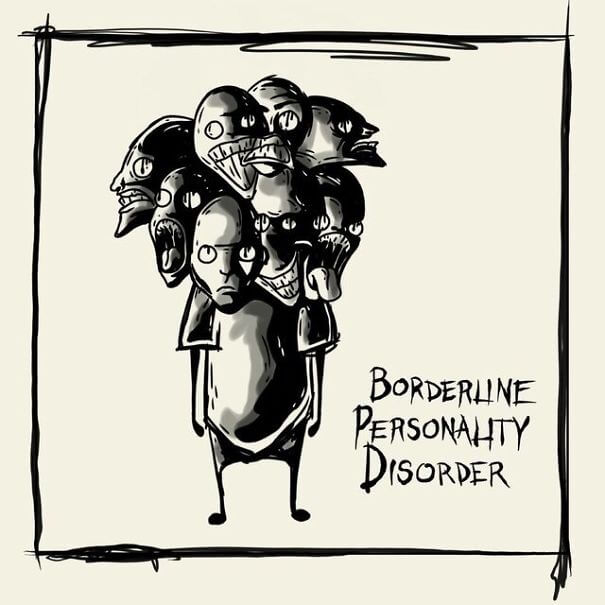 9
9 - Treatment Utilization: Men with BPD are less likely to utilize psychotherapy and pharmacotherapy services than their female counterparts.1
Thus, willingness or opportunity to use treatment services may contribute to different rates of BPD diagnoses given among men and women.
There are multiple widely utilized treatments for men with BPD. Generally,dialectical behavior therapy (DBT)–a structured treatment involving individual therapy, skills group, and phone coaching– is the front-line method chosen by practitioners. DBT emphasizes learning and implementing skills such as mindfulness, distress tolerance, emotion regulation, and interpersonal effectiveness. Due to the social and genetic components of BPD, involving loved ones in a person’s treatment plan through family therapy can optimize its outcomes.1o Some patients may also benefit from medication to help with symptom management.
Unfortunately, men are less likely to pursue treatment than women due to the negative stigmas associated with mental health. Oftentimes, men feel that they must live up to certain social masculine expectations, resulting in a subconscious resistance to seeking help. If you are struggling with the negative symptoms of BPD, you should consider reaching out to a therapist by exploring an online directory.
Final ThoughtsWhile BPD may feel hard to manage, with education and support there are certainly ways to move forward and build a successful life. Following an effective treatment plan and involving your loved ones in your journey are two steps to help you find relief from BPD symptoms.
Additional Resources
Education is just the first step on our path to improved mental health and emotional wellness. To help our readers take the next step in their journey, Choosing Therapy has partnered with leaders in mental health and wellness.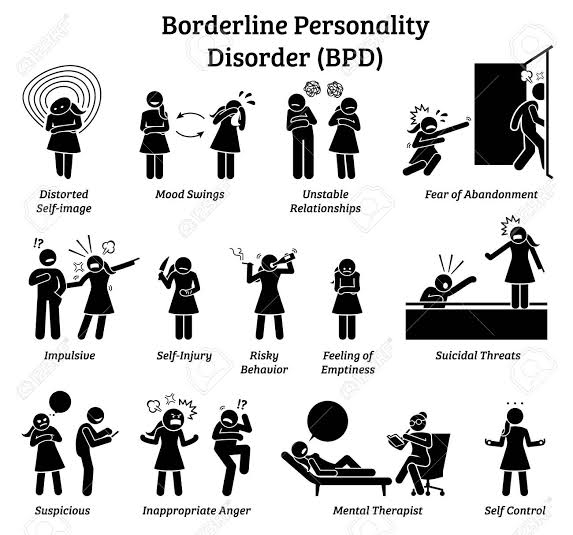 Choosing Therapy may be compensated for marketing by the companies mentioned below.
Choosing Therapy may be compensated for marketing by the companies mentioned below.
BetterHelp (Online Therapy) – BetterHelp has over 20,000 licensed therapists who provide convenient and affordable online therapy. BetterHelp starts at $60 per week. Complete a brief questionnaire and get matched with the right therapist for you. Get Started
Online-Therapy.com – Receive help for BPD. The Online-Therapy.com standard plan includes a weekly 45 minute video session, unlimited text messaging between sessions, and self-guided activities like journaling. Recently, they added Yoga videos. Get Started
Brightside Health (Online Psychiatry) – If you’re struggling with Borderline Personality Disorder (BPD), finding the right medication can make a difference. Brightside Health treatment plans start at $95 per month. Following a free online evaluation and receiving a prescription, you can get FDA approved medications delivered to your door.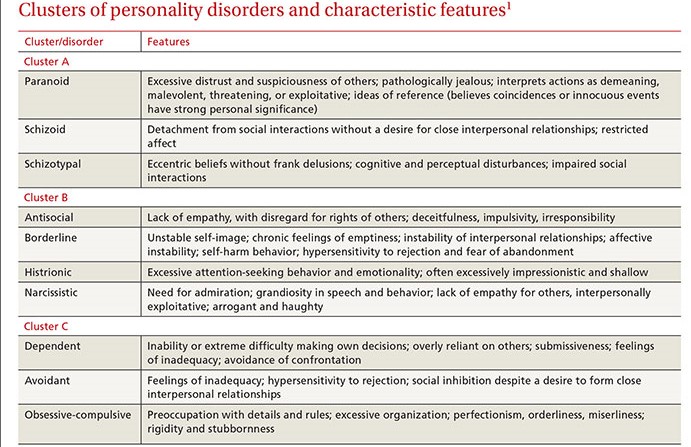 Free Assessment
Free Assessment
Choosing Therapy’s Directory – Find an experienced therapist specializing in BPD. You can search for a therapist by specialty, availability, insurance, and affordability. Therapist profiles and introductory videos provide insight into the therapist’s personality so you find the right fit. Use our therapist directory to find a therapist today.
Choosing Therapy partners with leading mental health companies and is compensated for marketing by BetterHelp, Online-Therapy.com, and Brightside
For Further Reading
- NEABPD
- NewYork-Presbyterian Hospital
- Borderline personality disorder: An information guide for families
- Healing from BPD
10 sources
Choosing Therapy strives to provide our readers with mental health content that is accurate and actionable. We have high standards for what can be cited within our articles. Acceptable sources include government agencies, universities and colleges, scholarly journals, industry and professional associations, and other high-integrity sources of mental health journalism.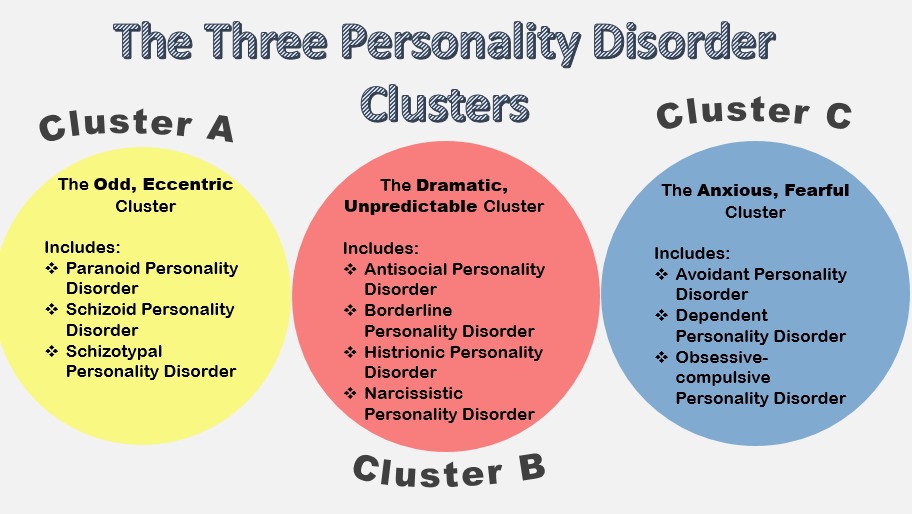 Learn more by reviewing our full editorial policy.
Learn more by reviewing our full editorial policy.
-
Sansone, R. A., & Sansone, L. A. (2011). Gender patterns in borderline personality disorder. Innovations in clinical neuroscience, 8(5), 16.
-
Bayes, A., & Parker, G. (2017). Borderline personality disorder in men: A literature review and illustrative case vignettes. Psychiatry research, 257, 197-202
-
Bertsch, K., Krauch, M., Roelofs, K., Cackowski, S., Herpertz, S. C., & Volman, I. (2019). Out of control? Acting out anger is associated with deficient prefrontal emotional action control in male patients with borderline personality disorder. Neuropharmacology, 156, 107463.
-
Paris, J., Chenard-Poirier, M. P., & Biskin, R. (2013). Antisocial and borderline personality disorders revisited. Comprehensive psychiatry, 54(4), 321-325.
-
Zlotnick, C., Rothschild, L., & Zimmerman, M. (2002). The role of gender in the clinical presentation of patients with borderline personality disorder.
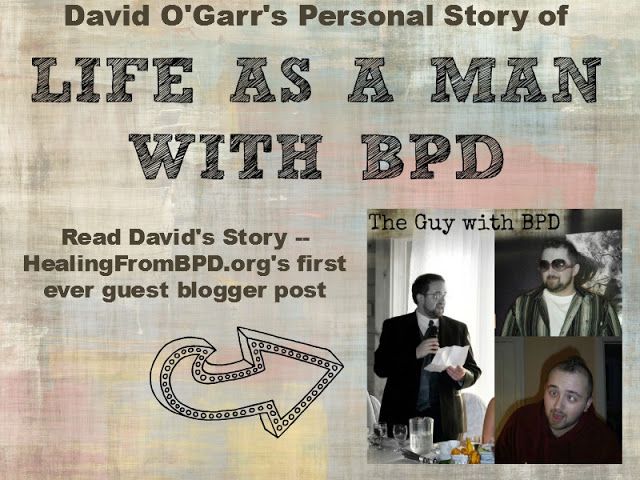 Journal of personality disorders, 16(3), 277-282.
Journal of personality disorders, 16(3), 277-282. -
Johnson, D. M., Shea, M. T., Yen, S., Battle, C. L., Zlotnick, C., Sanislow, C. A., … & Zanarini, M. C. (2003). Gender differences in borderline personality disorder: Findings from the Collaborative Longitudinal Personality Disorders Study. Comprehensive psychiatry, 44(4), 284-292.
-
Brickman, L. J., Ammerman, B. A., Look, A. E., Berman, M. E., & McCloskey, M. S. (2014). The relationship between non-suicidal self-injury and borderline personality disorder symptoms in a college sample. Borderline personality disorder and emotion dysregulation, 1(1), 1-8.
-
Euler, S., Stöbi, D., Sowislo, J., Ritzler, F., Huber, C. G., Lang, U. E., … & Walter, M. (2018). Grandiose and vulnerable narcissism in borderline personality disorder. Psychopathology, 51(2), 110-121.
-
Skodol, A. E., & Bender, D. S. (2003). Why are women diagnosed borderline more than men?. Psychiatric Quarterly, 74(4), 349-360.
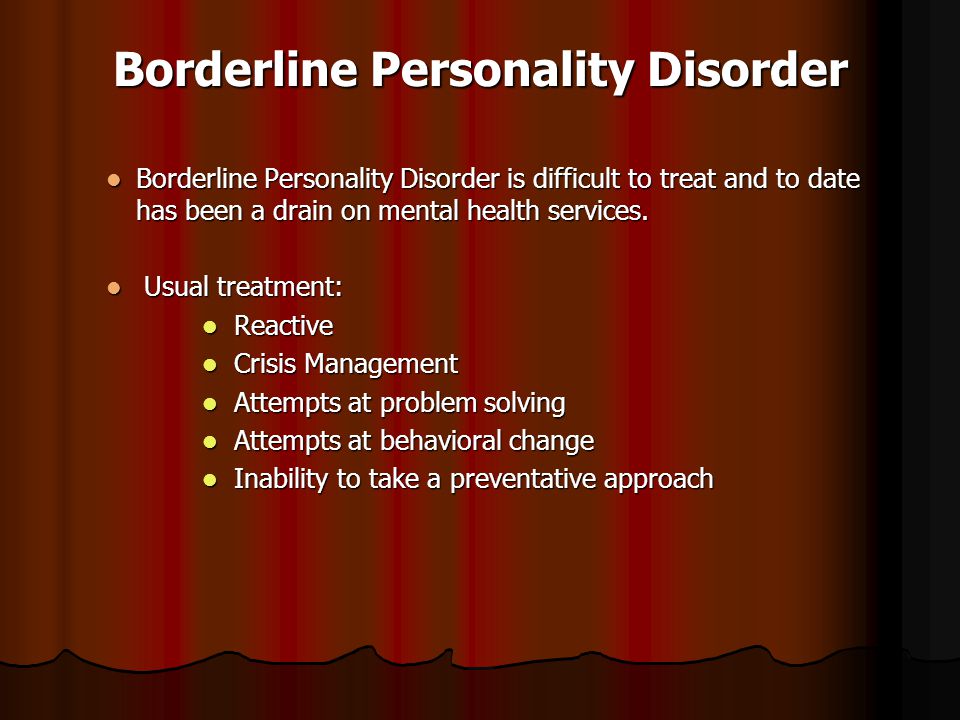
-
Fitzpatrick, S., Wagner, A. C., & Monson, C. M. (2019). Optimizing borderline personality disorder treatment by incorporating significant others: A review and synthesis. Personality Disorders: Theory, Research, and Treatment, 10(4), 297.
If you are in need of immediate medical help:
Medical
Emergency
911
Suicide Hotline
800-273-8255
Borderline personality disorder
Borderline personality disorder is associated with unstable mood and behavior that has a significant impact on a person's daily life
Borderline personality disorder is a type of personality disorder in which a person experiences periods of tension, unstable moods and behaviors, and an altered "feeling of self".1 All of these can result in impulsive actions and relationship problems with friends and family members, impairing the person's ability to cope with everyday life. 1.2
1.2
Borderline personality disorder is a serious illness associated with self-harm and suicidal attempts. One in ten patients complete suicide. 2
Facts About Borderline Personality Disorder
Borderline personality disorder is a type of personality disorder in which a person experiences periods of tension, unstable mood and behavior, and an altered sense of self. 1
One in ten patients complete suicide. 2
Patients with borderline personality disorder are very sensitive to changes in their environment, and may respond inappropriately and acutely to such changes. They may, for example, be afraid of being abandoned by a loved one.2 If the person whom patient
is expecting arrives late, the patient easily changes the feeling of attachment to dislike or anger. 1,2 This reflects the extreme perception of the world by the patient, who sees everything and everyone - including oneself – either good or bad.1,2
1,2 This reflects the extreme perception of the world by the patient, who sees everything and everyone - including oneself – either good or bad.1,2
People with borderline personality disorder are often insecure, may suddenly change their life goals and views on career, life values and friends. .2 They may develop intense unwarranted anger or feelings of emptiness, and are prone to self-harm.2 Patients with borderline personality disorder may also experience depression and anxiety.1,2
Facts about Borderline Personality Disorder
Estimates of the proportion of people who have borderline personality disorder vary from less than 1% to around 6%. 2-4
Borderline personality disorder affects a roughly equal number of men and women, but appears to be more disabling in women the same frequency in men and women, but in women it is more severe.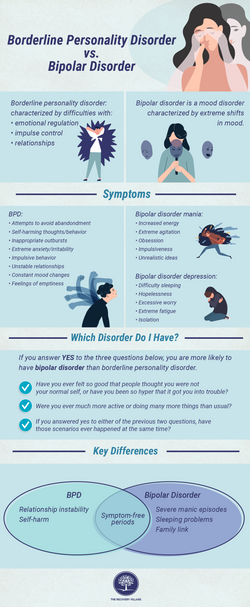 3
3
Symptoms of borderline personality disorder most often first appear during adolescence.4 The disease is most severe and problematic in young adults and tends to improve with age.2 Symptoms may persist throughout life, but most patients with borderline personality disorder by the age of 30-40 have a stable job and a home.2
People with borderline personality disorder are emotionally and functionally unstable, which places a significant burden on their families.5 Mood swings are a source of stress for both the patient and his/her others, which can lead to the development of mental disorders in the latter.1,5
People who are concerned that they – or their loved ones – are experiencing symptoms of borderline personality disorder should see their doctor for help and advice.
Borderline personality disorder is diagnosed by a mental health professional using interviews and discussions about symptoms and medical history. 1
1
Psychotherapy can help people with borderline personality disorder by, for example, teaching them how to interact with others and to express their thoughts and feelings more clearly. 1 It may also be beneficial for caregivers and family members of those affected to receive therapy and guidance on how best to care for a person with borderline personality disorder. 1 There is currently no cure, but one study showed that, after 10 years, 50% of people with borderline personality disorder had recovered, being able to function at work and maintain personal relationships. 6
- National Institute of Mental Health. borderline personality disorder. NIH publication number QF 17-4928. Available from: https://www.nimh.nih.gov/health/publications/borderline-personality-disorder/index.shtml [accessed 30 September 2019].
- American Psychiatric Association. Diagnostic and Statistical Manual of Mental Disorders.
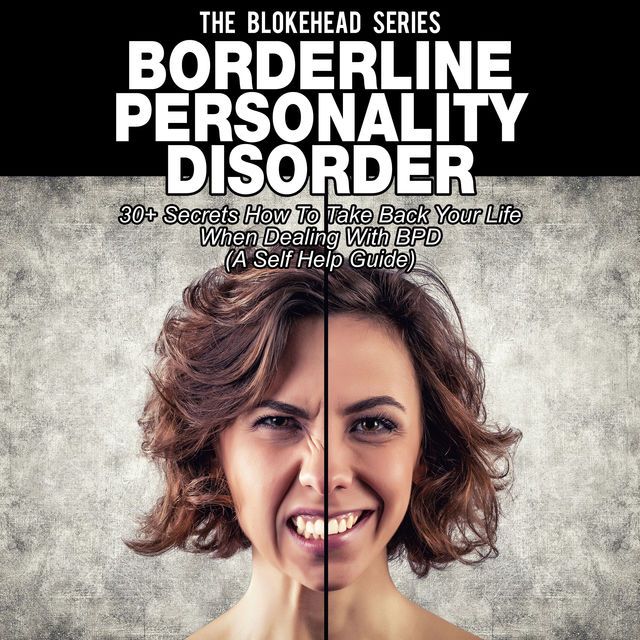 5th ed. Arlington, VA: American Psychiatric Association; 2013.
5th ed. Arlington, VA: American Psychiatric Association; 2013. - Grant BF, Chou SP, Goldstein RB, Huang B, Stinson FS, Saha TD, et al. Prevalence, correlates, disability, and comorbidity of DSM-IV borderline personality disorder: results from the Wave 2 National Epidemiologic Survey on Alcohol and Related Conditions. J Clin Psychiatry. 2008;69(4):533–545.
- National Institute for Health and Clinical Excellence. Borderline personality disorder: recognition and management. 2009. Available from: https://www.nice.org.uk/guidance/cg78/resources/borderline-personality-disorder-recognition-and-management-pdf-975635141317 [accessed 30 September 2019].
- Bailey RC, Grenyer BFS. Burden and support needs of carers of persons with borderline personality disorder: a systematic review. Harv Rev Psychiatry. 2013;21(5):248–258.
- Zanarini MC, Frankenburg FR, Reich DB, Fitzmaurice G. Time to attainment of recovery from borderline personality disorder and stability of recovery: a 10-year prospective follow-up study.
 Am J Psychiatry. 2010;167(6):663–667.
Am J Psychiatry. 2010;167(6):663–667.
1. National Institute of Mental Health. borderline personality disorder. NIH publication number QF 17-4928. Available from: https://www.nimh.nih.gov/health/publications/borderline-personality-disorder/index.shtml [accessed 30 September 2019].
2. American Psychiatric Association. Diagnostic and Statistical Manual of Mental Disorders. 5th ed. Arlington, VA: American Psychiatric Association; 2013.
3. Grant BF, Chou SP, Goldstein RB, Huang B, Stinson FS, Saha TD, et al. Prevalence, correlates, disability, and comorbidity of DSM-IV borderline personality disorder: results from the Wave 2 National Epidemiologic Survey on Alcohol and Related Conditions. J Clin Psychiatry. 2008;69(4):533–545.
4. National Institute for Health and Clinical Excellence. Borderline personality disorder: recognition and management. 2009. Available from: https://www.nice.org.uk/guidance/cg78/resources/borderline-personality-disorder-recognition-and-management-pdf-975635141317 [accessed 30 September 2019].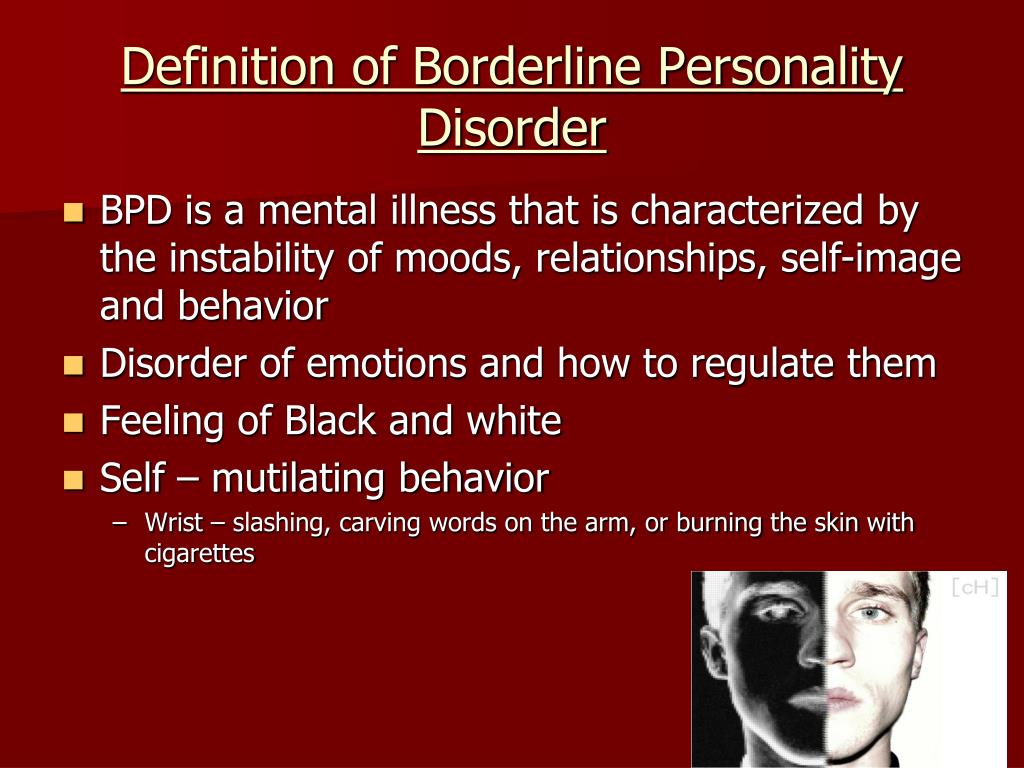
Access to Brain Health
We are dedicated to improving access to brain health in accordance with WHO.
Our Science
Lundbeck has developed some of the world’s most widely prescribed therapies.
This is Lundbeck
A specialized pharmaceutical company focused exclusively on brain diseases.
Borderline personality disorder: symptoms, treatment, communication tips
- What is it
- Test
- Symptoms
- Causes and risk factors
- Is it being treated
- How to communicate with a person with BPD
- Expert commentary
What is borderline personality disorder
Borderline personality disorder (BPD) inevitably affects how a person thinks and feels, how he interacts with others [1]. The diagnosis is recorded in the ICD-10 and is considered a subspecies of an emotionally unstable personality disorder. The disorder manifests itself in problems with self-esteem, the management of emotions and behavior, high anxiety and desocialization, and leads to unstable relationships with others. With borderline personality disorder, a person experiences a fear of being alone or abandoned. Misplaced anger, impulsiveness, frequent mood swings can alienate potential partners.
The diagnosis is recorded in the ICD-10 and is considered a subspecies of an emotionally unstable personality disorder. The disorder manifests itself in problems with self-esteem, the management of emotions and behavior, high anxiety and desocialization, and leads to unstable relationships with others. With borderline personality disorder, a person experiences a fear of being alone or abandoned. Misplaced anger, impulsiveness, frequent mood swings can alienate potential partners.
Advertising on RBC www.adv.rbc.ru
Deviations are usually recorded in young people and may worsen with age. However, many patients diagnosed with BPD are able to live a full life, having worked through the main problems.
Borderline Personality Disorder Test
Some of the symptoms may point directly to BPD, but only the attending physician will give exact information. If you suspect you have a disorder, answer a few questions:
- Do you have a fear of being alone that makes you act inappropriately? For example, constantly call a partner, try to be always near him.
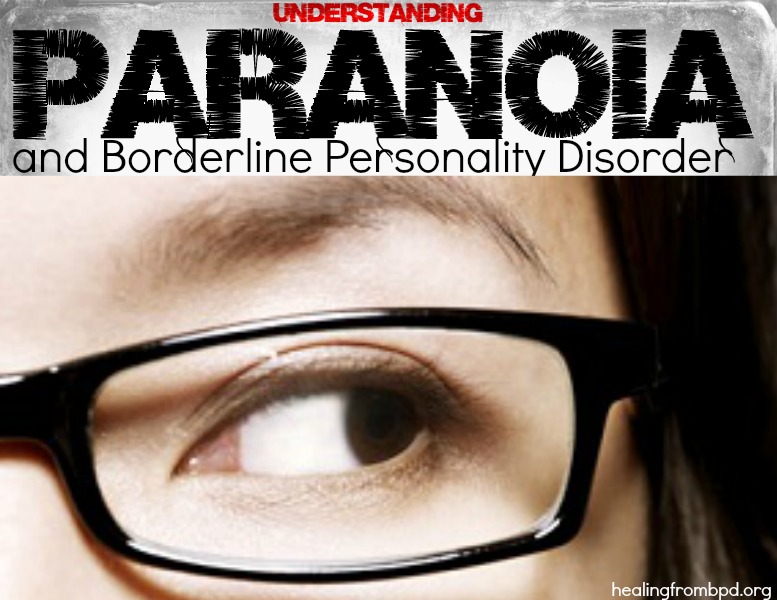
- Have you had to change your mind drastically in relation to your partner, to move from love to hatred for no particular reason?
- Have you ever felt that you do not have a clear idea of yourself, that you are not sure of your self-esteem?
- Have you committed impulsive dangerous acts? For example, have you taken drugs, spent large sums of money recklessly, or had unprotected sex?
- Have you harmed yourself, threatened suicide in the presence of loved ones?
- Do you experience severe mood swings, from anxiety and irritability to days of depression and apathy?
- Do you find it difficult to control your anger?
- When you find yourself in a stressful situation, do you feel as if you are disconnected from reality and your own body, do not control your thoughts and behavior?
If you answered "yes" to more questions, it makes sense to talk to a therapist. Symptoms do not always indicate borderline personality disorder and may be due to other health problems. Only a specialist can make a correct diagnosis and give competent advice.
Only a specialist can make a correct diagnosis and give competent advice.
© Yuris Alhumaydy/Unsplash
Symptoms of borderline personality disorder
BPD affects how a person relates to himself and others, how he behaves in society. Signs and symptoms vary, there may be several, or just a couple from the list [2]:
- Strong fear of being abandoned. A person is ready to go to extreme measures to avoid the real or imagined withdrawal or rejection of a partner.
- Tendency to unstable relationships. For example, a person idealizes a partner, but at some point suddenly decides that the latter is cruel and unfair.
- Rapid changes in self-identification and self-esteem. Goals and values switch disproportionately to the circumstances - abruptly and for no particular reason. A person tends to consider himself bad, he needs impulses from the outside in order to feel alive and needed.
- Stress related paranoia. Loss of contact with reality lasting from several minutes to several hours.
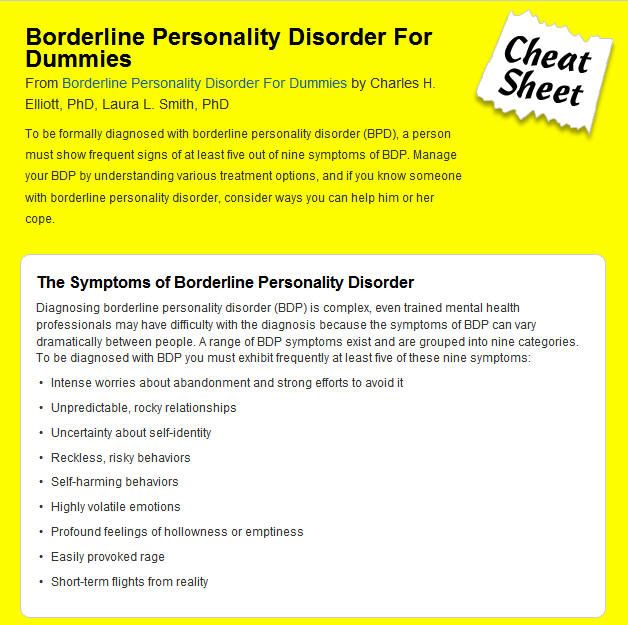
- Impulsive behavior, propensity to take risks. Gambling, reckless driving, unsafe sex, alcohol abuse, overeating, drugs.
- Success sabotage. Sudden unreasonable rejection of positive relationships, good work.
- Self-mutilation, suicidal tendencies. Often occur in response to separation anxiety or partner rejection.
- Sudden mood swings lasting from several hours to several days. Bright, hypertrophied emotions: happiness, anxiety, shame and irritability.
- Constantly accompanying feeling of emptiness, lack of interest in what is happening.
- Aggression - strong anger, cruel sarcastic remarks to interlocutors, fights.
Causes and risk factors
As with other mental health problems, the causes of borderline personality disorder are not fully understood. In addition to circumstances such as childhood abuse or neglect, borderline personality disorder may be associated with the following factors.
- Genetics.
 Studies involving twins and their relatives suggest that BPD may be inherited and be part of a mental health complex [3].
Studies involving twins and their relatives suggest that BPD may be inherited and be part of a mental health complex [3]. - Anomalies of the brain. Several studies have confirmed changes in certain parts of the brain involved in the regulation of emotions, especially impulsivity and aggression [4]. Patients with BPD may have malfunctions in the regulation of chemicals, such as the production of serotonin, which affects mood.
Is there a cure for borderline personality disorder
BPD is difficult to treat. But with the help of modern, evidence-based therapies, people with the disorder can be helped to manage their symptoms and improve their quality of life. It is good if the treatment is carried out by a licensed doctor who specializes in this disease. Sometimes the patient will need to interact not only with a psychiatrist, but also with a social worker who will help to adapt in the absence of loved ones.
The doctor usually conducts an interview and discusses the person's symptoms.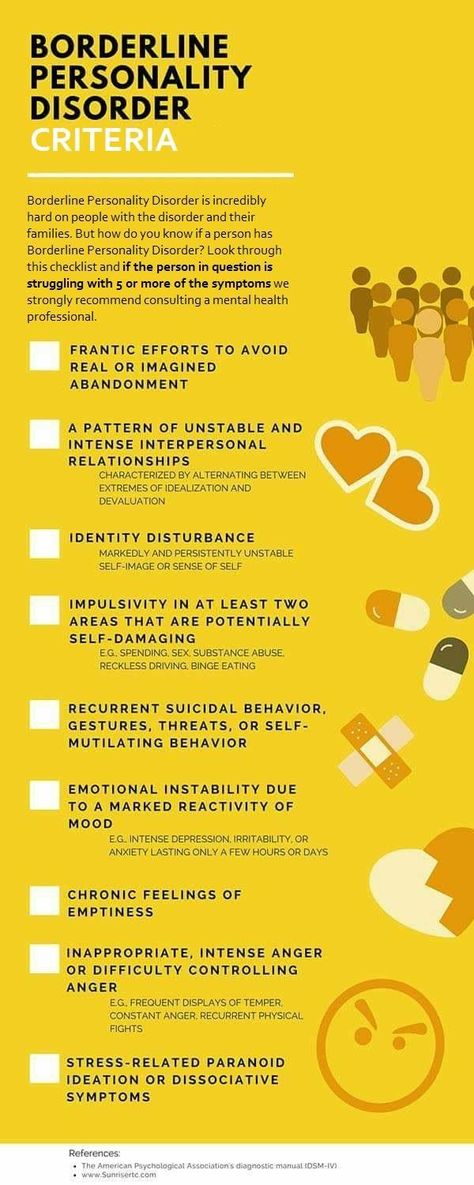 Then there is a thorough medical examination and testing, which allows you to exclude other diseases. Comorbid disorders can make BPD difficult to diagnose and treat, especially if their symptoms overlap. For example, a person may show signs of depression, bipolar disorder, anxiety, substance use problems, or eating disorders. If a patient with borderline personality disorder does not receive proper treatment, they are more likely to develop chronic illnesses. And not only mentally, but also physically - patients with BPD tend to make choices in favor of an unhealthy lifestyle and self-harm.
Then there is a thorough medical examination and testing, which allows you to exclude other diseases. Comorbid disorders can make BPD difficult to diagnose and treat, especially if their symptoms overlap. For example, a person may show signs of depression, bipolar disorder, anxiety, substance use problems, or eating disorders. If a patient with borderline personality disorder does not receive proper treatment, they are more likely to develop chronic illnesses. And not only mentally, but also physically - patients with BPD tend to make choices in favor of an unhealthy lifestyle and self-harm.
Psychotherapy is the first line of treatment for a person with BPD. It can take place both individually and in a group. The second option helps the patient to interact with other people and express himself in society. Most often, the doctor uses one of two therapy options, or combines them:
- Dialectical Behavioral Therapy (DBT). It uses the concepts of awareness and acceptance of the current situation and emotional state.
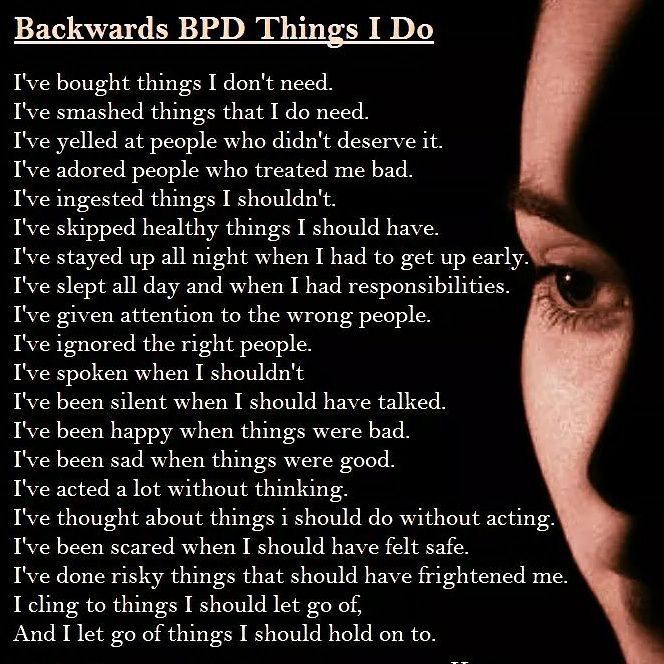 DBT also teaches skills to control and reduce self-destructive behavior.
DBT also teaches skills to control and reduce self-destructive behavior. - Cognitive behavioral therapy (CBT). This type of assistance allows you to identify and change the core beliefs that underlie inaccurate acceptance of yourself and others, as well as problems associated with communication.
Because their benefits are unclear, medications are not commonly used as the primary treatment for borderline personality disorder. However, in some cases, a psychiatrist may recommend medications to treat certain symptoms, such as controlling mood swings and depression. The psychotherapist should specialize in borderline personality disorder, that is, receive additional education in this area.
How to communicate with a person with BPD
People with BPD are often very suspicious and vulnerable. They need support, and it is important for them to realize that they have someone to turn to in case of exacerbations. Eliza Gordezki, a writer, artist and queer feminist with BPD, has developed a manual for interacting with people who have been diagnosed with BPD [5].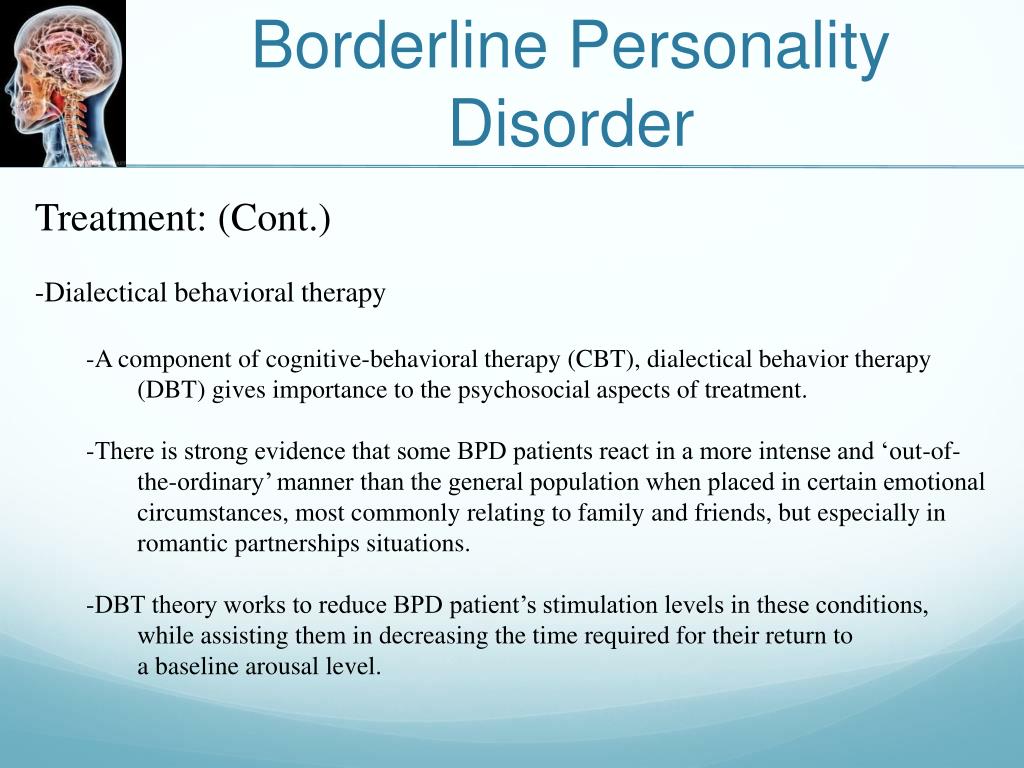 Here are the main recommendations.
Here are the main recommendations.
Tell loved ones that you will take care of them.
People with BPD tend to think that if they don't hear this confirmation, then they are indifferent to those around them. Suitable phrases:
- "Just writing to you to tell you I care about you."
- "I wanted you to know that I'm thinking of you right now."
- "I really like having you in my life and I wanted to make sure you knew that."
Take an interest in well-being and affairs
For people with BPD, this is a vicious circle: they are afraid of being rejected, so they do not share their experiences in order to eliminate the risks of negative reactions from others. Asking how you are doing is a good strategy for making contact.
- “Hi, how are you?”
- “I saw you posted a sad post on Facebook. I wanted to make sure you were okay."
Soften bad news with support and sympathy
When you tell your loved one some unpleasant information, try to remind him that he is important to you and that you will support him in any case.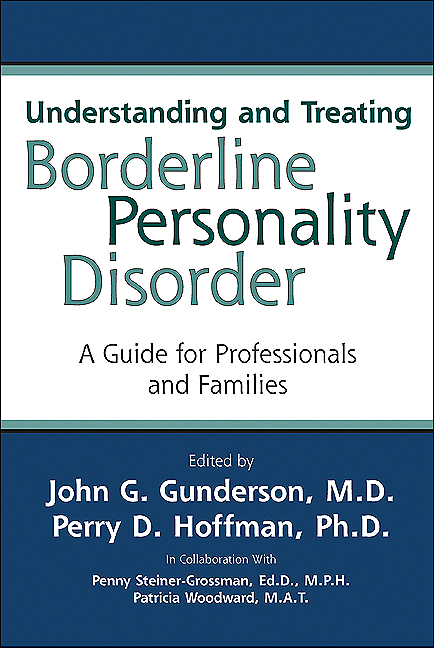 A person with BPD needs to be aware that his feelings are taken into account and not perceived as something feigned.
A person with BPD needs to be aware that his feelings are taken into account and not perceived as something feigned.
- "It's not easy for me to support you in this crisis, but I need to know what to do to make it easier for you to deal with it."
Match words
Marsha Linehan, who developed the Dialectical Behavior Model (one of the most common treatments for people with BPD), uses specific vocabulary in her manuals [6]. Rather than characterize a person or their actions with judgmental words, she prefers adjectives such as "efficient, skillful, and wise" (or the reverse, "inefficient, inept, and unwise"). These words separate a person from his behavior, they name qualities that can be changed. If someone is being violent, negative, or insulting, you can say something like:
- “I can see you're upset. I understand why you are upset, but these actions are very inefficient and will not bring you the desired results. Let's think together how we can achieve greater sense and achieve the desired prospects.

Compare this phrase with those that many people are used to using in similar situations: “It's not normal if you react like that!”, “It's impossible to communicate with you, there is too much drama”, “Why are you overreacting? You are always so sensitive!”
© Pavel Danilyuk/Pexels
Be attentive to triggers
The only way to determine what is bothering a loved one is to ask and observe. Among people with BPD, two triggers are common (eng. trigger - a reason, a trigger; in psychology - an irritant that causes a certain reaction) - to be thrown and to be rejected. Simple situations that most people are used to can cause a strong negative reaction with borderline personality disorder. For example, if you reschedule a meeting or began to devote more time to other things, did not respond to a message for a long time, or forgot to call. Of course, changing plans is normal, but when communicating with a person with BPD, it is worth taking a little time to explain your actions to him:
- “I remember that we planned to meet on Friday and have dinner together, and I'm sorry, but I have to cancel this meeting.
 I was assigned to make an urgent report, and I will be at work all evening. It will be great if, along with the cancellation of plans, you offer a quick alternative: “But I really want to spend time with you! Maybe we can meet on Saturday for lunch?
I was assigned to make an urgent report, and I will be at work all evening. It will be great if, along with the cancellation of plans, you offer a quick alternative: “But I really want to spend time with you! Maybe we can meet on Saturday for lunch?
Repeat and confirm
People with BPD need to be reminded of your positive attitude. Frequent reinforcement and support is an important part of their well-being and confidence in the world. Be patient and focus on good moments, convince your loved one if he breaks into negative emotions, even if it seems to you that they are unreasonable. For example, your friend is upset that they don't reply to a message. At this point, he may seriously believe that the interlocutor hates him. Inform that this is not the case, most likely, the person is just busy, he will definitely write or call as soon as he has time.
What works well for one person may not work for another, so it's always best to talk to your loved ones and ask what they need.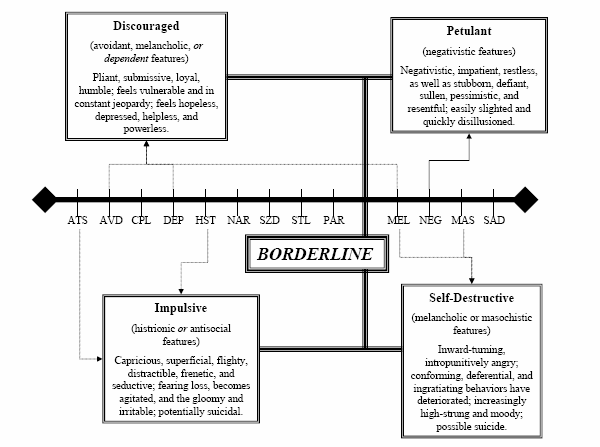
Expert comment
Andrey Yudin, psychologist, Gestalt therapist, co-founder of Stemning Gestalt Center
It is not always possible to build relationships with a person with BPD [7]. But if it's not a destructive abusive relationship and it's important for you to keep the relationship going, you need to put in a lot of effort. First of all, set boundaries - when you can come or call, whether you can shout. Sometimes it can take years to rebuild, especially when it comes to older relatives. It will take a lot of labor and therapeutic support.
Borderline personality disorder is one of the three basic personality disorders in modern psychotherapy, the other two being schizoid and narcissistic. BPD is the most well studied and isolated, it is in the public eye due to its clinical manifestations. The disorder is included in the ICD-10, but the difficulty lies in the lack of uniform criteria for the diagnosis. There are three obvious signs of borderline personality disorder:
- The person does not take care of himself.
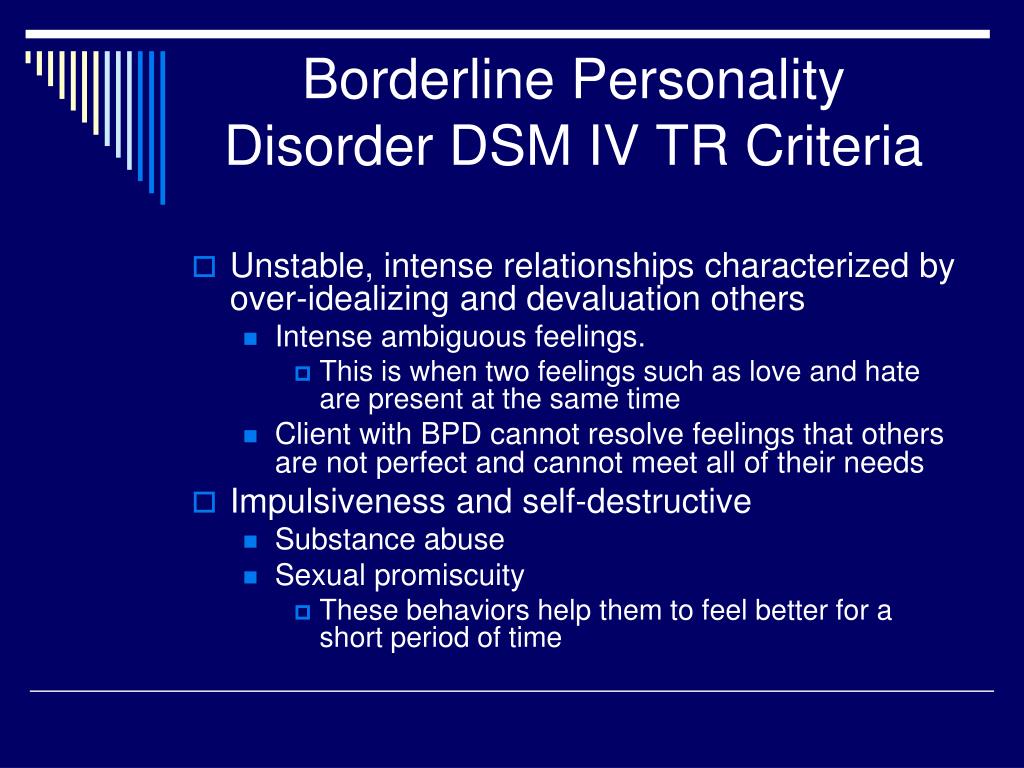 For example, he does not visit doctors, while experiencing guilt and shame for his choice. This factor applies to both hygiene and personal relationships.
For example, he does not visit doctors, while experiencing guilt and shame for his choice. This factor applies to both hygiene and personal relationships. - Approach speed. People with BPD tend to quickly make contacts and just as quickly become disillusioned with new acquaintances, friends, and romantic relationships.
- Extreme fear of rejection. If a person is afraid of being abandoned, being rejected by relatives, friends or partners, then this is a clear sign of BPD.
With BPD, there is a clear lack of self-activation - inducing oneself to some kind of action. At the same time, it is difficult for a person to explain to himself why he cannot do this. Trying to rouse himself to action, he begins to worry. Borderline personality disorder begins in childhood, between 16 and 24 months. It is often the result of severe abuse, physical, emotional or sexual abuse, or a parent's negative response to a child's need for emotional closeness. In the case of premature separation, a mental structure is formed from two separate parts, which normally should be integrated into each other, but in BPD these are two separate modules.
BPD is often associated with drug addiction. Suffering, feelings of frustration, dissatisfaction encourage a person to chemically regulate his emotional state. This is alcohol, and drugs, and self-damaging behavior, and not only in relation to the body. For example, a person can spend all the money on payday.
With regard to BPD during adolescence, for this stage of human development, many of the "symptoms" are actually normal behavior. Severe emotional experiences, dulling the sense of self-preservation, experiments with substances and partners. But from the age of 16-18, when the transitional stage has been passed, the persistence of these signs may be a reason to contact a specialist.
Those close to people with BPD face, first of all, their emotional instability. The biggest difficulty is the chaotic influence on the lives of others. If a person with a narcissistic disorder extends his suspiciousness to the assessments of others, then with BPD people tend to have a different focus - love / not love, rejection / acceptance.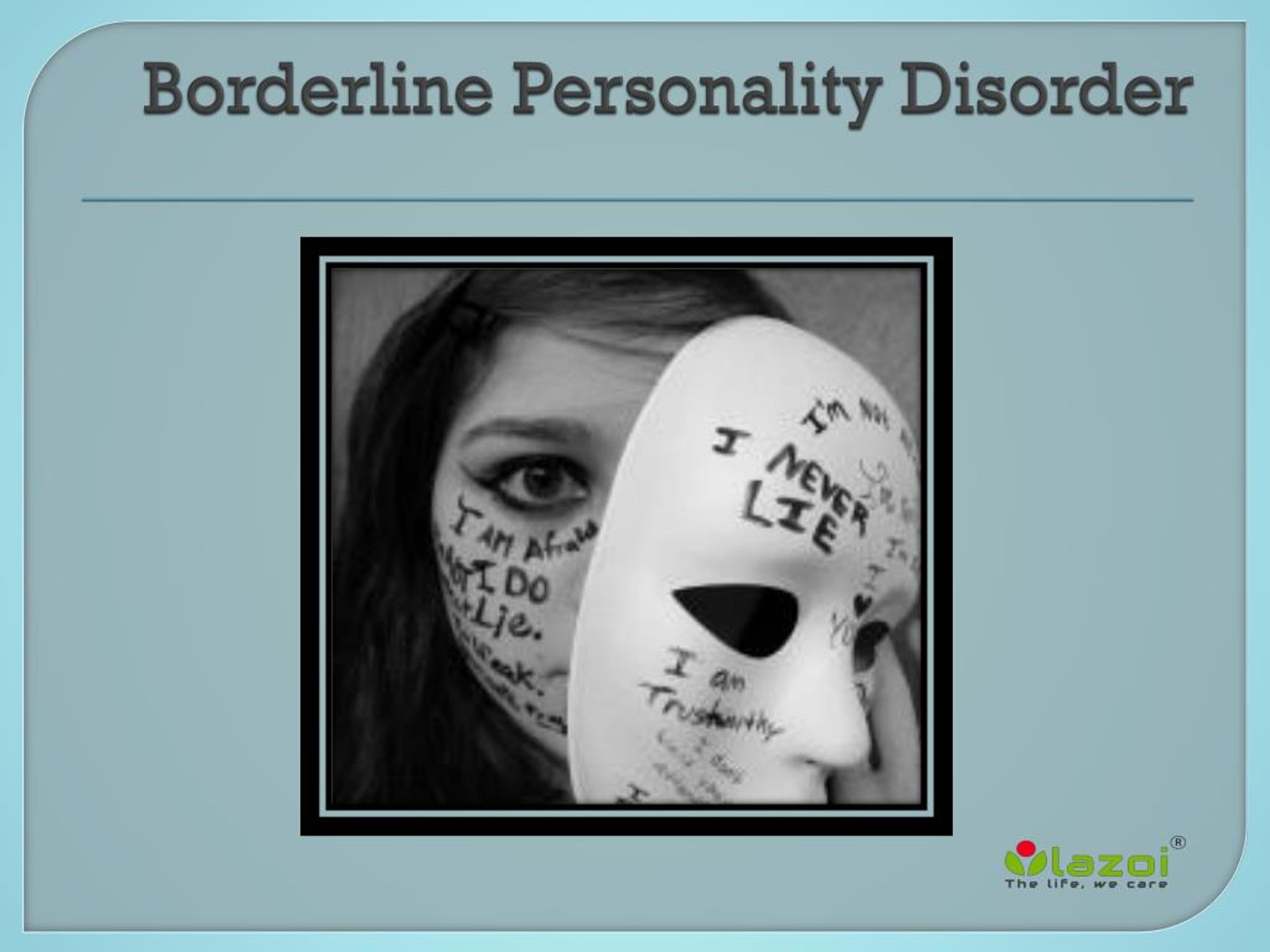 A person may try to return the location of the partner or play ahead of the curve - break off the relationship, if he assumes that he may be abandoned. People with BPD may become abusers because of the unbearable emotional experiences they are trying to change in this way.
A person may try to return the location of the partner or play ahead of the curve - break off the relationship, if he assumes that he may be abandoned. People with BPD may become abusers because of the unbearable emotional experiences they are trying to change in this way.
In the professional field, BPD can be suspected, for example, in rock stars. Moreover, the presence of such a feature for people in this profession will even be a plus. There will be a lot of life and pain in their work, it is very sincere and can be healing for other people.
If you encounter a person with BPD at work—a boss, a colleague, a subordinate—they are likely to have fairly loose boundaries because they find it difficult to set and maintain them. This may be a person who perfidiously treats other people's borders or, conversely, distances himself and avoids communication. People with BPD are very successful. Such bosses have reactive behavior, chaos in the department, and many will be uncomfortable.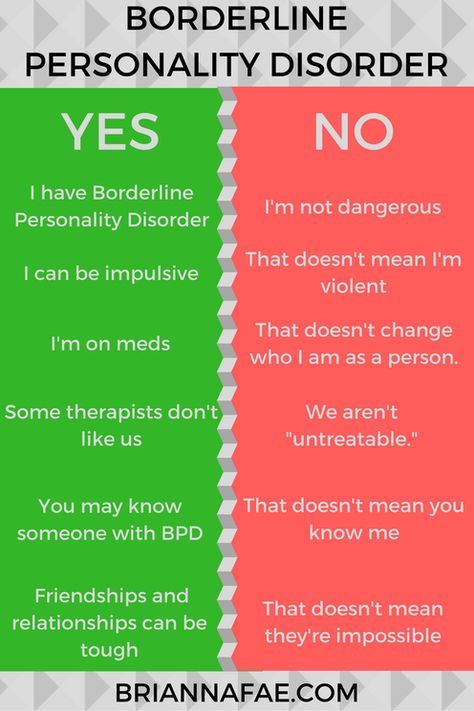 But there are qualities in BPD that are good for management: empathy, intuition, even being aggressive can be an asset for career advancement.
But there are qualities in BPD that are good for management: empathy, intuition, even being aggressive can be an asset for career advancement.
The diagnosis and treatment of borderline personality disorder requires a specific set of skills that are not taught in psychology departments, at least not in basic education programs. Most psychologists do not have such qualifications; a maximum of 10% of practicing specialists have it. Therefore, educational work is especially important so that people can find the understanding and support that are so needed. The peculiarity of therapy for BPD will be directed to the very two modules of consciousness (patterns) of the patient. A person with BPD may go to the doctor from their positive childhood pattern and talk about how well the treatment is working. He does this because he is used to being held in relationships in this way, he has learned that he must give positive emotional nourishment "so as not to be abandoned." The therapist must frustrate this pattern, help to go beyond it.